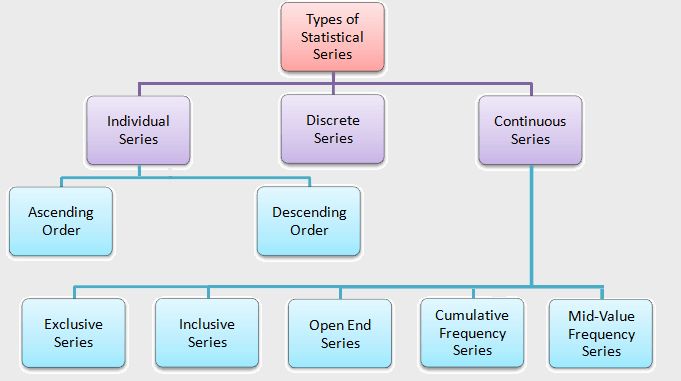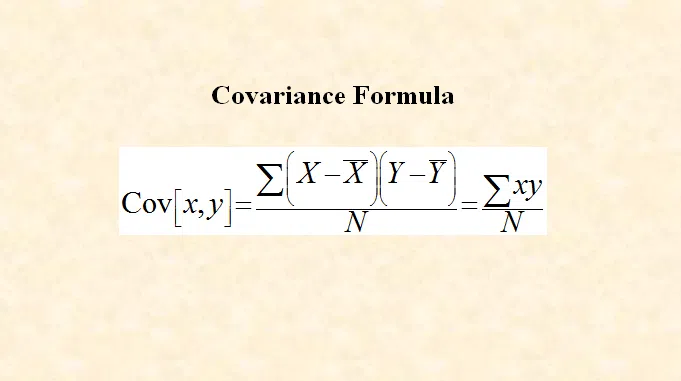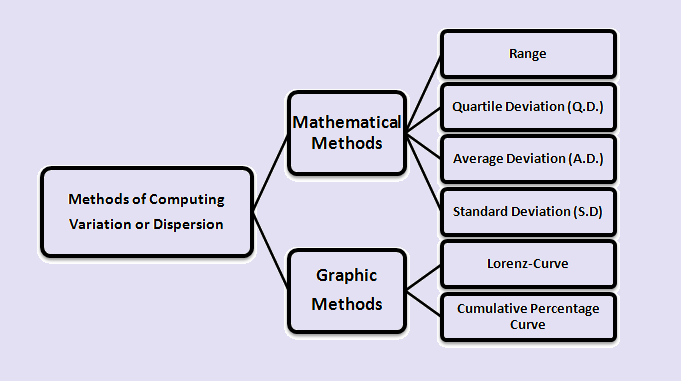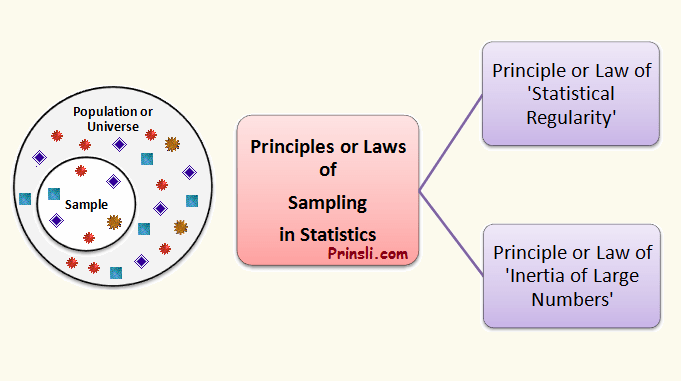
Inclusive Series:
Inclusive series is a kind of continuous series, in which an item equal to the upper limit of a class is included in that class itself. As a result, an inclusive series includes both the upper and lower limits of the class interval. However, there is a gap between the upper limit of one class and the lower limit of the next class in inclusive types of class intervals.
For example; continuous series such as 5-9, 10-14, 15-19, 20-24… is called an inclusive series. In such an inclusive series, the upper limit of one class is not equal to the lower limit of the next class. Here, all values larger than or equal to any class’s lower limit and less than or equal to its upper limit are included in it.
In the inclusive series: 5-9, 10-14, 15-19, 20-24…, the class 5-9 will mean, all values between 5 and 9 including 5 and 9 also. Similarly, class 10-14 means individual values between 10 and 14 including 10 and 14 also.
Because in this type of series, both the upper and lower limits of the class interval are included in that class interval, it is referred to as an inclusive series.
In other words, when the data are classified in such a way that both lower and upper limits of a class interval are included in the interval itself, then it is called the inclusive method of classifying data.
A serious problem in the case of the inclusive method is the values that lie between the two classes. For example, in the inclusive series: 5-9, 10-14, 15-19, 20-24…, if an item has a value of 9.5, which class should it be placed in? Because of this problem, the inclusive method is not generally employed. However, the problem of where to put the 9.5 value can be handled by changing the series using the exclusive method.
Remember that, in an inclusive method, the width of a class interval is calculated by subtracting the lower limit of that class from the lower limit of the next class.
For example, if classes are 5-9, 10-14, 15-19, 20-24…, then the class width of 5-9 is 5, not 4. Because to find the width of a class interval ‘5-9’, we subtract the lower limit of the class ‘5-9′ from the lower limit of the next class ’10-14’, so, the width of the class ‘5-9’ will be 10-5=5.
Therefore, an inclusive series is used when there is a certain difference in the values of various items in the data.
Example of an Inclusive Series:
The following are the marks scored by the 20 students in a class out of a total of 100. If the marks scored by the 20 students in the class are given individually, it will form an Individual series, as shown follows:
90, 55, 35, 78, 51, 57, 60, 55, 55, 85, 78, 80, 35, 41, 61, 55, 62, 64, 55, 19.
This data can be represented in an inclusive series as follows:
| Marks (X)
Class-intervals |
No. of Students
(Frequency f) |
| 0-19 | 1 |
| 20-39 | 2 |
| 40-59 | 8 |
| 60-79 | 6 |
| 80-99 | 3 |
| Total | 20 |
Inclusive Series in Hindi
समावेशी श्रेणी या सम्मिलित श्रेणी (Inclusive Series):
समावेशी श्रृंखला एक प्रकार की सतत श्रृंखला है, जिसमें किसी वर्ग की उच्च सीमा अगले वर्ग की निम्न सीमा के बराबर नहीं होती है, अर्थात इस श्रेणी में किसी वर्ग की ऊपरी सीमा (उच्च सीमा) का मान उस वर्ग में ही सम्मिलित किया जाता है। नतीजतन, एक समावेशी श्रृंखला में वर्ग अंतराल की ऊपरी (उच्च) और निचली (निम्न) दोनों सीमाएँ उस वर्ग अंतराल में ही शामिल होती हैं, अर्थात समावेशी विधि में एक ही सीमा दो अलग-अलग वर्गों में नहीं आती। हालांकि, समावेशी प्रकार के वर्ग अंतरालों में एक वर्ग की ऊपरी सीमा और अगले वर्ग की निचली सीमा के बीच गैप (फासला, या अन्तराल) होता है।
उदाहरण के लिए; सतत श्रृंखला जैसे 5-9, 10-14, 15-19, 20-24… को समावेशी श्रृंखला कहा जाता है। ऐसी समावेशी श्रृंखला में, एक वर्ग की ऊपरी सीमा अगले वर्ग की निचली सीमा के बराबर नहीं है, अर्थात एक वर्ग की ऊपरी सीमा अगले वर्ग की निचली सीमा से अलग है। इसके किसी भी वर्ग में, उस वर्ग की निचली सीमा से बड़े या उसके बराबर और उसकी ऊपरी सीमा से कम या उसके बराबर सभी मान इसमें शामिल होते हैं। समावेशी श्रृंखला: 5-9, 10-14, 15-19, 20-24…, में; कक्षा 5-9 का अर्थ है 5 और 9 के बीच के सभी मान जिसमें 5 और 9 भी शामिल हैं। इसी तरह, कक्षा 10-14 का अर्थ है 10 और 14 के बीच के सभी मान जिसमें 10 और 14 भी शामिल हैं।
क्योंकि इस प्रकार की श्रृंखला में, वर्ग अंतराल की ऊपरी और निचली दोनों सीमाएँ उस वर्ग अंतराल में शामिल होती हैं, इसे समावेशी श्रृंखला कहा जाता है।
दूसरे शब्दों में, जब आँकड़ों को इस प्रकार वर्गीकृत किया जाता है कि एक वर्ग अंतराल की निचली और ऊपरी दोनों सीमाएँ उस वर्ग अंतराल में ही शामिल हो जाती हैं, तो इसे आँकड़ों को वर्गीकृत करने की समावेशी विधि कहा जाता है।
समावेशी पद्धति के मामले में एक गंभीर समस्या उन प्रेक्षणों की है जिनका मान दो वर्गों के बीच में हैं।
उदाहरण के लिए, समावेशी श्रृंखला: 5-9, 10-14, 15-19, 20-24…, में; यदि किसी प्रेक्षण का मान 9.5 है, तो उसे किस वर्ग में रखा जाना चाहिए? इसी समस्या के कारण आम तौर पर समावेशी पद्धति का उपयोग नहीं किया जाता है। हालांकि, अपवर्जी विधि का उपयोग करके श्रृंखला को बदलकर 9.5 मान को कहां रखा जाए, इसकी समस्या को नियंत्रित किया जा सकता है।
याद रखें कि, समावेशी पद्धति में, एक वर्ग अंतराल की चौड़ाई की गणना उस वर्ग की निचली सीमा को अगले वर्ग की निचली सीमा से घटाकर की जाती है।
उदाहरण के लिए, यदि वर्ग 5-9, 10-14, 15-19, 20-24… हैं, तो कक्षा 5-9 की वर्ग चौड़ाई 5 है, न कि 4। क्योंकि एक वर्ग अंतराल ‘5-9’ की चौड़ाई ज्ञात करने के लिए, हम वर्ग ‘5-9′ की निचली सीमा 5 को अगली कक्षा ’10-14’ की निचली सीमा 10 से घटाते हैं, इसलिए, वर्ग ‘5-9’ की चौड़ाई 10-5=5 होगी।
इसलिए, एक समावेशी श्रृंखला का उपयोग तब किया जाता है जब डेटा में विभिन्न मदों के मानों में एक निश्चित अंतर होता है।
(Source – Various books from the college library)
Copyrighted Material © 2019 - 2024 Prinsli.com - All rights reserved
All content on this website is copyrighted. It is prohibited to copy, publish or distribute the content and images of this website through any website, book, newspaper, software, videos, YouTube Channel or any other medium without written permission. You are not authorized to alter, obscure or remove any proprietary information, copyright or logo from this Website in any way. If any of these rules are violated, it will be strongly protested and legal action will be taken.




Be the first to comment